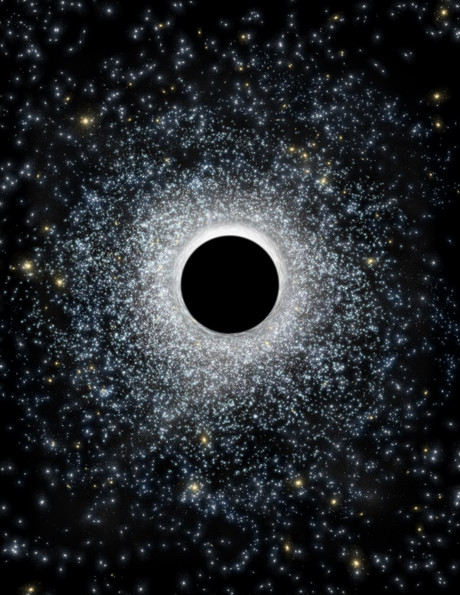In the red corner: the world's first middleweight black hole

US and Australian astronomers have announced evidence for the existence of a ‘middleweight’ black hole — otherwise known as the missing link between relatively small, stellar-mass black holes and the supermassive black holes that lie at the centre of some galaxies.
Until now, all known black holes fell into one of two categories: stellar-mass black holes, weighing a few times the mass of Earth’s Sun; and supermassive black holes, weighing millions or billions of times more than that. Astronomers also suspected that intermediate-mass black holes (IMBHs) weighing 100 to 10,000 times the mass of our Sun also existed, but no conclusive proof of such middleweights existed.
“We want to find intermediate-mass black holes because they are the missing link between stellar-mass and supermassive black holes,” said the lead author of the new study, Bülent Kızıltan, from the Harvard-Smithsonian Center for Astrophysics (CfA). “They may be the primordial seeds that grew into the monsters we see in the centres of galaxies today.”
Together with CfA colleague Abraham Loeb, as well as Holger Baumgardt from The University of Queensland, Kızıltan investigated the 12-billion-year-old star cluster 47 Tucanae, located 13,000 light-years from Earth in the constellation of Tucana the Toucan. Study of the cluster was always going to be tricky, as black holes can usually be detected if they are ‘feeding’ on nearby gas — unfortunately, the centre of 47 Tucanae is gas-free, effectively starving any black hole that might lurk there.
Luckily, the new research relies on two lines of evidence, the first of which is the overall motions of stars throughout the cluster.
A globular cluster’s environment is so dense that heavier stars tend to sink to the centre of the cluster. An IMBH at the cluster’s centre acts like a cosmic ‘spoon’ and stirs the pot, causing those stars to slingshot to higher speeds and greater distances. This imparts a subtle signal that astronomers can measure. By employing computer simulations of stellar motions and distances, and comparing them with visible-light observations, the team found evidence for just this sort of gravitational stirring.
The second line of evidence comes from pulsars — compact remnants of dead stars contained within the cluster whose radio signals are easily detectable. Like the live stars, these objects are flung about by the gravity of the central IMBH, causing them to be found at greater distances from the cluster’s centre than would be expected if no black hole existed.

Combined, this evidence indicates the presence of an IMBH of about 2200 solar masses within 47 Tucanae — the first black hole of its mass known to science. The research has been published in the journal Nature and suggests that similar IMBHs may be hiding in other globular clusters.
Colon cancer DNA in blood can guide chemo decisions
A simple blood test could change how doctors decide which patients with colon cancer need...
Non-invasive blood test helps rule out oesophageal cancer
Designed and developed in Australia, the PromarkerEso test is designed to offer a quick,...
Taste-based flu test enables rapid diagnosis
The diagnostic tool consists of the sensor molecule thymol and a virus-specific sugar building...





